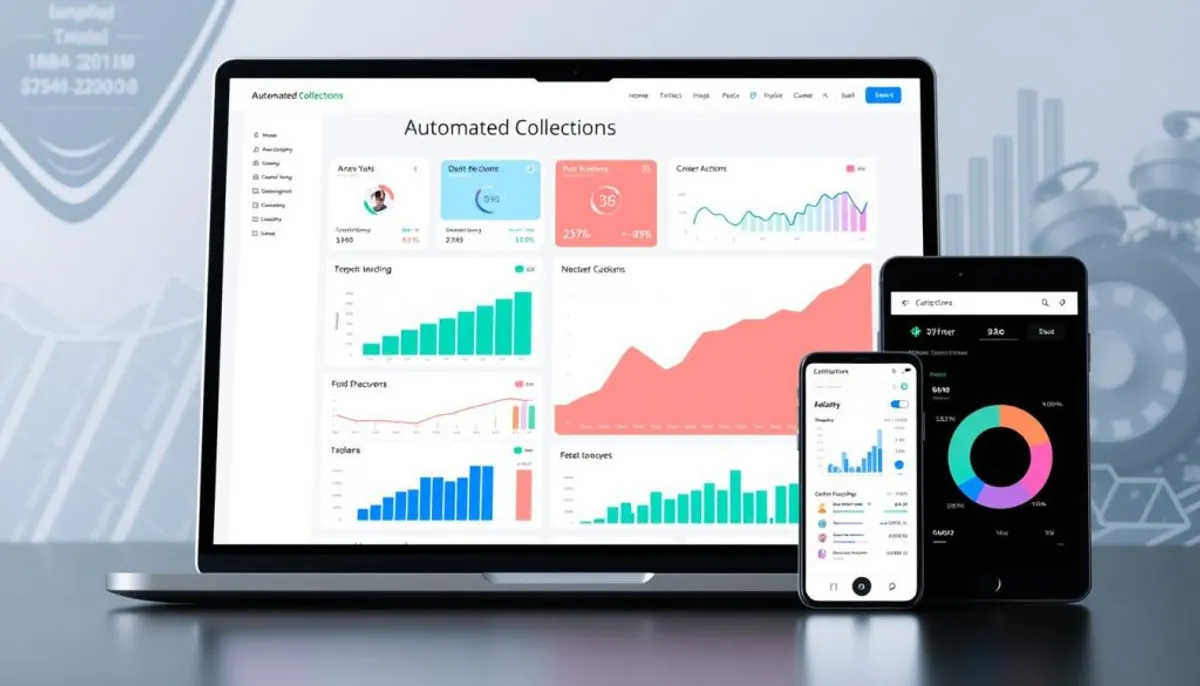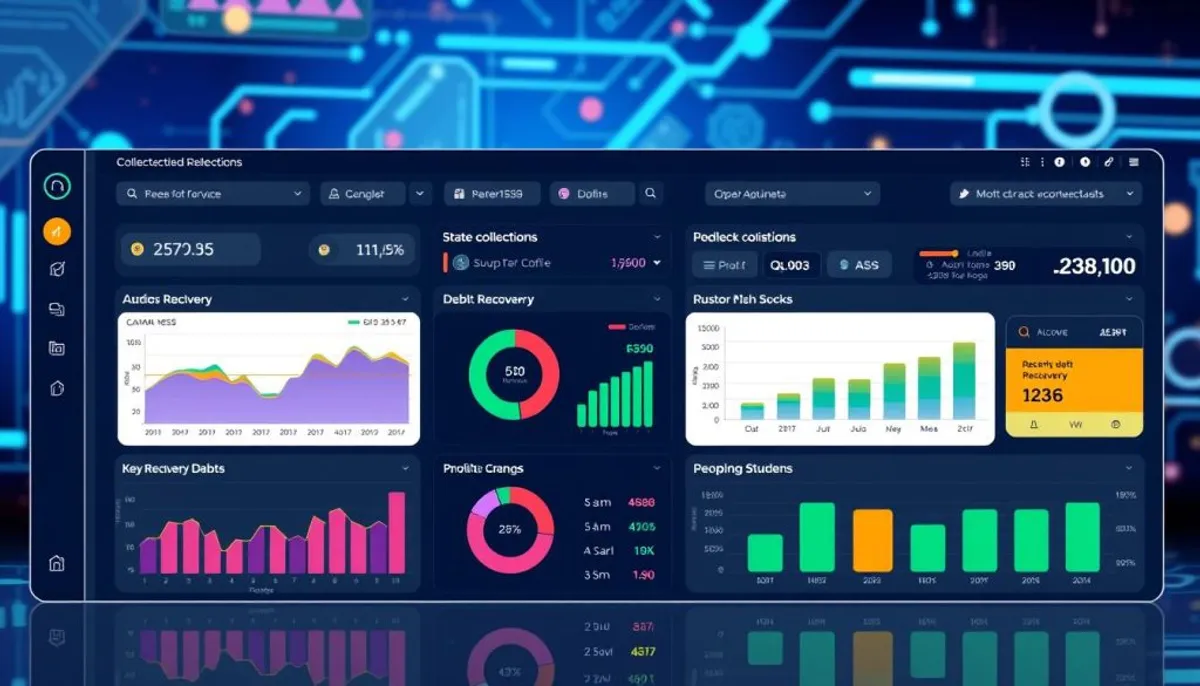In today’s fast-paced business world, managing debt recovery can be a daunting task. Enter automated collections, a game-changer for finance teams worldwide. This innovative debt recovery software is transforming how businesses handle past due accounts and boost their cash flow.
Collections management systems powered by AI are revolutionizing the industry. These tools automate emails, reduce overdue accounts, and provide real-time insights. The result? Faster payments and increased productivity for your team.

Let’s look at some impressive numbers. Companies using automated collections have seen a 4x increase in weekly past due coverage. They’ve doubled their collection calls and expanded their outreach tenfold. That’s not all – businesses report a 60% boost in collection rates through strategic automation.
But it’s not just about numbers. These systems ensure polite and respectful communication with customers. They can handle interactions in over 150 languages, making them truly global solutions. Plus, they integrate seamlessly with payment portals for a smooth debt recovery experience.
Key Takeaways
- Automated collections increase past due coverage by 4x
- AI-powered systems boost collection rates by 60%
- Debt recovery software handles 150+ languages
- Seamless integration with payment portals
- Ensures polite and respectful customer communication
- Provides real-time insights for better decision-making
Understanding the Current State of Debt Recovery Challenges
The realm of debt recovery has evolved into a complex domain. The business environment is now beset by an uptick in late payments, cash flow strain, and the inadequacy of traditional collection methodologies. This necessitates the adoption of novel approaches in receivables management.
Rising Late Payment Statistics in Business
Across various sectors, late payments have emerged as a pressing issue. Statistics indicate that more than half of U.S. business invoices encounter delays. This development exerts considerable pressure on enterprises, with 42% of them dedicating increased time to past-due account recovery.
Impact on Business Cash Flow
The repercussions of delayed payments are far-reaching, affecting a company’s cash flow. Such strain hampers growth prospects and erodes investor confidence. Businesses are thus ensnared in a cycle of payment pursuit, diverting resources away from core activities and expansion.
Traditional Collection Methods Limitations
Traditional debt recovery strategies are falling short. In-house efforts often lack the efficiency required, while outsourcing to agencies can jeopardize customer relationships. These methods face challenges in scalability and operational control, underscoring the imperative for automated debt collection solutions.
| Challenge | Impact | Solution |
|---|---|---|
| Late Payments | Strained Cash Flow | Collections Automation |
| Manual Processes | Inefficiency | Automated Debt Collection |
| Limited Scalability | Reduced Growth | Receivables Management Software |
In the face of these challenges, the imperative for effective receivables management is evident. Collections automation presents a viable solution, overcoming the shortcomings of traditional methods and facilitating more efficacious debt recovery strategies.
The Evolution of Automated Collections
The collections landscape has undergone a significant transformation. Traditional manual processes are giving way to sophisticated automated systems, revolutionizing the collections lifecycle. These modern platforms efficiently manage delinquent accounts, streamlining the entire collections workflow.
Automated collections have addressed key shortcomings of manual processes. They offer automated reminders, issue escalation, and seamless payment collection from overdue customers. This evolution provides a cost-effective alternative to traditional debt collection agencies while maintaining positive client relationships.
| Metric | Manual Process | Automated Process |
|---|---|---|
| Follow-up on late payments | 24 days (average) | 16 days (average) |
| Time spent on customer contact | 25% | 75% |
| Payment error margin | High | Significantly reduced |
| Report generation | Manual, time-consuming | Automated, efficient |
Automated collections management software integrates with financial systems, enabling effective risk management through creditworthiness checks and payment information verification. This integration enhances the overall collections workflow, leading to improved recovery rates and reduced administrative costs.
Key Features of Modern Collection Management Systems
Today’s collection management systems are equipped with advanced tools to streamline debt recovery processes. These platforms integrate cutting-edge technologies, enhancing efficiency and effectiveness in automated collections.
AI-Powered Prioritization
Debt recovery software now employs AI to analyze payment data, predicting customer behavior. This smart prioritization focuses efforts on accounts most likely to pay, significantly improving collection rates.
Automated Communication Workflows
Collections management systems feature customizable email templates and scheduled notifications. Users can send bulk emails to 50, 100, or even 1000 customers at once, saving time and ensuring consistent communication.
Real-time Payment Tracking
Modern platforms utilize Robotic Process Automation to access AP portals and retrieve payment statuses in real-time. This feature allows for quick follow-ups and accurate cash flow forecasting.
Custom Report Generation
Advanced collections management systems leverage Natural Language Processing for automated note-taking and summary creation. This technology enables the generation of detailed, customized reports to track performance and identify trends.
| Feature | Benefit |
|---|---|
| AI Prioritization | Increases collection rates |
| Automated Workflows | Saves time, improves consistency |
| Real-time Tracking | Enhances cash flow management |
| Custom Reports | Facilitates data-driven decisions |
These features collectively transform debt recovery processes, making them more efficient and effective. By implementing a modern collections management system, businesses can significantly improve their accounts receivable management and overall financial health.
Maximizing Collection Efficiency Through Technology
Technology has transformed receivables management, significantly enhancing collection efficiency. Modern tools streamline processes, segment customers with precision, and offer vital analytics. These advancements are revolutionizing automated debt collection.
Streamlined Workflow Automation
Collections automation has cut manual tasks by 30%, boosting productivity. It automates tasks such as sending reminders and tracking payments. This frees up teams to handle complex cases, elevating debt recovery efficiency.
Intelligent Customer Segmentation
AI systems analyze over 20 variables to rank customers. This intelligent segmentation enables tailored collection strategies. High-risk accounts receive immediate attention, while low-risk ones are approached more gently. This approach increases recovery rates and preserves customer goodwill.
Performance Analytics
Real-time analytics inform data-driven decisions in receivables management. Teams monitor critical metrics like accounts receivable turnover and days sales outstanding. These insights enable early detection of cash flow issues and prompt strategy adjustments.
By embracing these technological advancements, businesses can dramatically improve their collection processes. Automation slashes operational costs, while intelligent segmentation and analytics foster more effective strategies. The outcome is a more efficient, customer-centric debt collection approach. This enhances recovery rates and strengthens business relationships.
Benefits of Implementing Collection Software
Collection software is a transformative tool for businesses grappling with delinquent accounts. It optimizes the collections workflow, significantly enhancing efficiency and cash flow. This innovation is crucial for companies seeking to streamline their financial operations.
Research indicates that the adoption of collection software yields substantial benefits:
- 20% reduction in past due accounts
- 40% increase in productivity
- 10x increase in automated emails
These outcomes result in quicker recovery of past due payments and increased team efficiency.
The software’s AI-driven prioritization enables teams to concentrate on high-risk accounts. This focus optimizes the collections workflow. Real-time payment tracking ensures that all information is current and accurate, essential for effective debt recovery.
Automated communication workflows facilitate personalized outreach on a large scale. This method aligns with consumer preferences, as 71% of customers seek personalized service. By utilizing these features, businesses can enhance their collections lifecycle while preserving positive customer relationships.
Integration with existing finance systems ensures data accuracy and compliance throughout the collections process. This integration accelerates debt recovery and provides valuable insights for strategic decision-making.
| Metric | Improvement |
|---|---|
| Payment Speed | 20% faster |
| Bad Debt Reduction | 15-25% |
| Finance Cost Savings | $20,000 per $10M revenue |
By adopting collection software, businesses can revolutionize their accounts receivable management. This leads to improved cash flow and enhanced financial performance.
Transform Your Accounts Receivable Management
Automated collections are transforming the landscape of accounts receivable management, offering significant advantages to businesses. By adopting debt recovery software, companies can enhance their financial standing and customer relationships substantially.
Reduced Manual Effort
Collections management systems dramatically reduce manual tasks, freeing up staff to engage in more strategic activities. The integration of one-click calling and automated note-taking simplifies processes. This efficiency can lead to an 80% reduction in cash collection time.
Improved Recovery Rates
AI-driven tools in automated collections software significantly improve recovery rates. Smart email responses and summaries empower teams to address overdue accounts more efficiently. With automation, businesses can strive for a Collection Effectiveness Index (CEI) near 100, indicating peak performance.

Enhanced Customer Experience
Debt recovery software centralizes communication, providing a seamless experience for customers. Automated task creation based on customer responses ensures prompt follow-ups. This personalized approach fosters customer loyalty while accelerating the receivables process.
Implementing automated collections can dramatically enhance a company’s accounts receivable turnover ratio. This leads to superior cash flow management and financial health. With the right collections management system, businesses can revolutionize their AR processes. They can reduce Days Sales Outstanding to below 30 days and collect up to 99% of receivables efficiently.
Integration Capabilities and System Requirements
Modern collections automation software boasts robust integration capabilities. These systems seamlessly connect with existing Enterprise Resource Planning (ERP) platforms and payment gateways. This integration enhances automated debt collection processes and streamlines receivables management.
ERP System Integration
Integrating collection software with ERP systems is crucial for efficient automated debt collection. It allows real-time data synchronization, reducing manual data entry and errors. This integration enables businesses to have a unified view of their financial data, improving decision-making in receivables management.
Payment Gateway Compatibility
Collections automation software must be compatible with various payment gateways. This compatibility ensures smooth processing of payments and quick updates to accounts. It supports multiple payment methods, making it easier for debtors to settle their dues and improving overall collection rates.
Security Protocols
Robust security measures are essential in receivables management systems. These include encryption of sensitive data, multi-factor authentication, and regular security audits. Such protocols protect financial information and maintain compliance with industry regulations.
| Integration Feature | Benefit |
|---|---|
| ERP Integration | 30% increase in collector productivity |
| Payment Gateway Compatibility | 20% reduction in past due accounts |
| Advanced Security Protocols | 100% compliance with data protection regulations |
By leveraging these integration capabilities, businesses can significantly improve their collections processes. HighRadius, a leader in collections automation, reports that their software enables 84% collections efficiency and a 13% reduction in past due accounts. These improvements highlight the transformative power of well-integrated automated debt collection systems.
Measuring Success in Automated Debt Recovery
Tracking key performance indicators is crucial for evaluating the effectiveness of your collections workflow. By monitoring specific metrics, you can gauge the success of your automated debt recovery efforts. This helps identify areas for improvement in managing delinquent accounts.
One essential metric is the Days Sales Outstanding (DSO). This measure calculates the average time it takes to collect payments after a sale. A lower DSO indicates faster collections, which is vital for maintaining healthy cash flow. Another important indicator is the Collection Effectiveness Index (CEI). This ratio compares the amount of cash collected to total outstanding receivables, providing insight into your debt recovery strategies’ success.
The Average Days Delinquent (ADD) metric offers valuable information about how long overdue accounts remain unpaid. This helps prioritize collection activities throughout the collections lifecycle. The Promise-to-Pay Rate measures the percentage of payment commitments made by customers against total receivables. It offers a glimpse into future payment likelihood.
| Metric | Description | Impact |
|---|---|---|
| Days Sales Outstanding (DSO) | Average time to collect payments | Lower DSO indicates faster collections |
| Collection Effectiveness Index (CEI) | Ratio of cash collected to total receivables | Higher CEI shows successful debt recovery |
| Average Days Delinquent (ADD) | Time overdue accounts remain unpaid | Helps prioritize collection activities |
| Promise-to-Pay Rate | Percentage of payment commitments | Indicates likelihood of future payments |
By consistently monitoring these metrics, businesses can fine-tune their collections workflow. This improves recovery rates for delinquent accounts and optimizes the overall collections lifecycle.
Best Practices for Implementation and Adoption
Implementing automated collections and debt recovery software necessitates meticulous planning. Success is contingent upon effective staff training, adept change management, and diligent performance tracking. Let’s dissect key strategies to ensure a seamless adoption of your new collections management system.
Staff Training Requirements
Comprehensive training is paramount for unlocking the full potential of your debt recovery software. Hands-on training sessions empower staff to master system features and workflows. Develop user guides and provide continuous support to address any emerging questions.
Change Management Strategies
Transparent communication is essential when introducing new automated collections processes. It’s crucial to articulate the rationale behind the change and the anticipated benefits. Engage team members in the implementation process to foster buy-in and address concerns promptly.
Performance Monitoring
Monitoring key metrics is indispensable to gauge the impact of your collections management system. Essential KPIs include:
- Days Sales Outstanding (DSO)
- Average Days Delinquent (ADD)
- Collection Effectiveness Index (CEI)
- Accounts Receivable Turnover Ratio (ART)

Regular performance reviews are crucial for identifying areas for enhancement and refining your debt recovery processes.
| Common Implementation Mistakes | Best Practices |
|---|---|
| Underestimating data quality importance | Ensure clean, accurate customer data |
| Ignoring specific needs analysis | Tailor system to company size and objectives |
| Neglecting personalization | Customize for industry and customer segments |
| Lack of clear objectives | Define specific goals for collection process |
| Excluding end-users from planning | Involve staff and IT in decision-making |
Adopting these best practices will equip your team for success with automated collections technology. The ultimate goal is to streamline processes, elevate recovery rates, and enhance the customer experience.
Conclusion
Automated debt collection has transformed the management of receivables for businesses. The transition from traditional methods to automated systems has been transformative. Companies such as Box have witnessed significant enhancements in their cash flow performance through these advancements.
Statistics underscore the effectiveness of Automated Collection Systems (ACS). They have collected billions in open Taxpayer Delinquent Accounts. Despite ongoing challenges, the trend is evident: automation simplifies processes, minimizes errors, and strengthens customer relationships. This technology not only boosts collection rates but also offers deep insights into customer behavior and repayment patterns.
As businesses evolve, automated collections will remain essential for maintaining healthy cash flows and liquidity. By utilizing AI for prioritization and real-time analytics, companies can revolutionize their accounts receivable processes. This leads to a reduction in past due accounts and a significant improvement in their financial health. The advent of automated debt recovery marks a new era in financial management.
RelatedRelated articles



